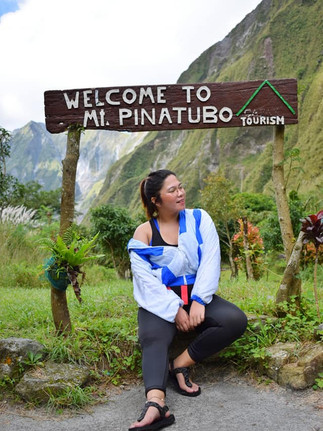Discover the Hidden Majesty of Mt. Pinatubo: A Journey to the Crater of History & Travel Guide
- Qing Pineda
- May 17
- 4 min read
Updated: May 20

Imagine standing at the edge of a shimmering turquoise crater lake, surrounded by towering cliffs carved by one of the most powerful volcanic eruptions of the 20th century. Mt. Pinatubo, located on the island of Luzon in the Philippines, is a destination that blends raw natural beauty with a profound sense of history. Once a dormant volcano, it famously erupted in 1991, reshaping the landscape and forming what is now one of the most breathtaking sights in Southeast Asia. For adventurers, nature lovers, and history buffs alike, Mt. Pinatubo offers an unforgettable travel experience that’s both humbling and exhilarating. I've put together a simple and handy Mt. Pinatubo travel guide —hope it helps!
Mt. Pinatubo Travel Guide
Best Time to Visit
Ideal Months: November to early May: The best time to hike Mt. Pinatubo is during the dry season, especially from December to February, when temperatures are cooler, and skies are clearer. Avoid the rainy season (June–October), as trails become slippery and access may be restricted due to safety concerns.
Insider Tip: Visit on weekdays to avoid crowds and enjoy a more serene experience at the crater lake.
Top Attractions
1. Mt. Pinatubo Crater Lake
The highlight of the trip, this surreal lake was formed after the 1991 eruption. Its vibrant blue-green hue is mesmerizing, especially under a clear sky.
Insider Tip: Arrive early to capture the best photos before the sun gets too harsh and crowds arrive.
2. 4x4 Off-Road Adventure
The journey begins with a thrilling 4x4 ride across lahar canyons and river crossings. The bumpy ride is part of the adventure and offers panoramic views of barren but beautiful volcanic landscapes.
3. Trekking Trail
A moderate trek of about 5.5 km (one-way) leads to the crater. The trail is beginner-friendly, with a mix of rocky paths and riverbeds.
4. Aeta Community Encounter
On some tours, you’ll pass through areas inhabited by the Aeta people, one of the Philippines' indigenous tribes. Respectful interaction is encouraged and offers a glimpse into their resilient way of life.
Local Cuisine
Don’t miss the chance to savor Kapampangan cuisine, known as one of the best in the Philippines.
Must-Try Dishes:
Sisig – A sizzling pork dish seasoned with calamansi, chili, and onions.
Tocino and Longganisa – Sweet and savory cured meats, perfect for breakfast.
Pancit Luglug – Noodles topped with shrimp sauce and crispy garlic.
Recommended Spots:
Everybody’s Café (San Fernando) – Authentic Kapampangan dishes in a traditional setting.
Susie’s Cuisine – Famous for local delicacies and snacks like tibok-tibok (milk pudding).
Personal Stories
Reminiscing about the stories my grandparents used to tell about the 1991 eruption of Mt. Pinatubo always fills me with a strange mix of awe and sorrow. Growing up in Pampanga, I heard countless firsthand accounts—neighbors who lost their homes, friends of the family who fled through clouds of ash, and relatives who remembered the sky turning dark at noon. The landscapes I grew up with were forever changed, marked by layers of ash and silence.
For years, I imagined Mt. Pinatubo as a place of destruction. But when I finally saw it with my own eyes, standing at the edge of that stunning crater lake, I was struck by how something so beautiful could rise from such devastation. The trek, the laughter along the trail, the stillness at the summit—it felt like the mountain was finally at peace.
Visiting Mt. Pinatubo wasn’t just a hike for me; it was a deeply personal journey. It brought those childhood stories full circle and reminded me how nature, even in its most violent moments, has the power to heal and transform. Today, Mt. Pinatubo stands not only as a geological wonder but as a living memory—of resilience, rebirth, and the enduring spirit of discovery.
Travel Tips
Packing Tips
Essentials: Sunscreen, water bottle (at least 2L), trail snacks, hat, lightweight rain jacket, trekking shoes.
Optional: Walking stick, GoPro/camera, power bank, extra clothes for changing after the trek.
Safety Tips
Always book with a licensed guide or tour company.
Check the weather forecast before your trip.
Bring cash, as ATMs and credit card machines are not available in remote areas.
Stay hydrated and pace yourself—heat exhaustion is real.
Cultural Etiquette
Greet locals with a smile or simple "po" and "opo" to show respect.
Don’t take photos of the Aeta people without permission.
Avoid littering—respect the natural environment.
Mt. Pinatubo isn’t just a trek—it’s a journey through history, nature, and community. From the roaring 4x4 rides to the quiet majesty of the crater lake, every step is a reminder of nature's unpredictable beauty. Whether you’re chasing adventure or looking for a meaningful escape, Mt. Pinatubo is waiting to leave its mark on your heart.
Have you been to Mt. Pinatubo? Share your experience and travel guide in the comments below or tag us on Instagram @qingtravels!
For more Philippine adventures, check out our post on The Ultimate Banaue Rice Terraces Guide. Don’t forget to subscribe for more budget-friendly travel tips and destination guides!




















Comments